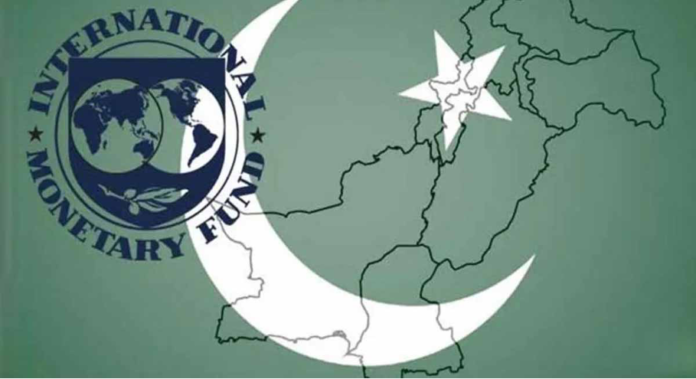By: Dr. Sahibzada Muhammad Usman
In its preliminary analysis, the IMF discovered a violation of over Rs 2,000 billion in budgetary forecasts for 2022–23, which may cause the budget deficit and primary deficit objectives to increase by a significant margin ahead of meaningful negotiations with Pakistani government.
Officials from Pakistan and the International Monetary Fund (IMF) are set to begin negotiations in order to complete the ninth review under the Extended Fund Facility. The fiscal slippages and the reconciliation of numbers will be the main discussion topics during this review. The evaluation would result in the release of Pakistan’s pending next installment of funding, which has been delayed since September. Prior to the budget release for 2022–23, the government had projected a budget deficit objective of 4.9% of the GDP and a primary deficit to maintain it at positive 0.2% of the GDP.
The IMF is presently requesting that Pakistani authorities implement extra taxing measures totaling Rs 600 billion via a mini-budget. Senior IMF officials have also decided to include an increase in circular debt owed by Pakistan’s cash-strapped energy industry over the ceiling previously agreed upon with the lender of last resort as part of the primary deficit for the current fiscal year 2022–2023. Meanwhile, Pakistan has asked the IMF for a 500-billion-rupee waiver on account of flood-related expenses to determine the budget deficit. According to the IMF’s current estimates, the primary deficit goal of 0.2% of GDP would be missed by a huge margin of more than Rs 1 trillion.
According to the IMF’s assessment, the coalition government failed to recoup the Rs 65 billion gasoline price adjustment for the current fiscal year. The government provided gas and electricity at reduced rates to export-oriented industries, which led to a rise in demand of Rs 110 billion.
Due to its reserves falling to a crucial level of USD 3.7 billion and the need for immediate assistance to prevent default, Pakistan is experiencing the greatest economic crisis. The IMF can only save the nation. But with no long-term strategy in place to deal with circumstances of the same economic nature, many people are concerned about the nation’s future.
In 2019, Pakistan received a USD 6 billion bailout from the IMF. In 2022, it was increased by an additional USD 1.1 billion to aid the nation in the wake of devastating floods. However, the IMF halted payments in November 2022 as a result of Pakistan’s inability to advance its fiscal consolidation efforts amid political unrest in the nation.
In the meantime, the government shouldn’t concentrate simply on providing short-term comfort. On June 30, the existing loan agreement will come to an end, and the lender will provide us with cash worth up to USD 3 billion. This could cover our short-term balance-of-payments demands, but it won’t be enough to handle a similar payments issue in the next fiscal year and beyond. Therefore, it is advised that the government work to expand the IMF program and its funding.
Less than $3.7 billion, or only three weeks’ worth of imports, are now in the country’s state bank. At the Karachi Port, there is a backlog of tens of thousands of cargo containers full of goods. The country cannot pay because it no longer gives out letters of credit for anything except food and medicine. The ban on imports and the significant currency depreciation have severely hurt businesses. Domestic investment has stalled, public building projects have been put on hold, and textile mills have partly shut down. Numerous day laborers, including painters and carpenters, wait for employment that never materializes. While the number of workers has reduced, the number of beggars has climbed.
Pakistan is caught in a never-ending cycle of paying off foreign debt. Before the conclusion of the fiscal year in June, according to State Bank Governor Jamil Ahmed, the nation owed $33 billion in loans and other foreign obligations. With $8.3 billion still up for negotiation, lending countries have rolled over $4 billion as part of a diplomatic push. As a result of inadequate infrastructure and bad management, Pakistan is now experiencing acute energy shortages, worsening the situation for both enterprises and civilians.
The country’s political shambles are mirrored in the economy’s decline, with former Prime Minister Imran Khan putting pressure on the current coalition to call early elections while his popularity is still strong. In 2019, Mr. Khan was removed from office by a resolution of no confidence and secured an IMF loan deal worth several billions of dollars. However, he broke his vows to reduce the market interventions and subsidies that had softened the cost-of-living issue, which led to the program’s stop. More than two dozen IMF accords negotiated and subsequently canceled have become a regular pattern in Pakistan, where most of the population lives in rural poverty.
About Author:
Dr. Sahibzada Muhammad Usman
Research Scholar and Academic; Ph.D. in Political Science at the University of Pisa, Italy. Dr. Usman has participated in various national and international conferences and published 30 research articles in international journals.
Email: s.usman@studenti.unipi.it






